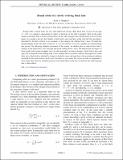Bound orbits of a slowly evolving black hole
Author(s)
Hughes, Scott A
DownloadPublished version (408.0Kb)
Publisher Policy
Publisher Policy
Article is made available in accordance with the publisher's policy and may be subject to US copyright law. Please refer to the publisher's site for terms of use.
Terms of use
Metadata
Show full item recordAbstract
© 2019 American Physical Society. Bound orbits of black holes are very well understood. Given a Kerr black hole of mass M and spin S=aM2, it is simple to characterize its orbits as functions of the orbit's geometry. How do the orbits change if the black hole is itself evolving? How do the orbits change if the orbiting body evolves? In this paper, we consider a process that changes a black hole's mass and spin, acting such that the spacetime is described by the Kerr solution at any moment, or that changes the orbiting body's mass. Provided this change happens slowly, the orbit's actions (Jr, Jθ, Jφ) are adiabatic invariants, and thus are constant during this process. By enforcing adiabatic invariance of the actions, we deduce how an orbit evolves due to changes in the black hole's mass and spin and in the orbiting body's mass. We demonstrate the impact of these results with several examples: how an orbit responds if accretion changes a black hole's mass and spin; how it responds if the orbiting body's mass changes due to accretion; and how the inspiral of a small body into a black hole is affected by change to the hole's mass and spin due to the gravitational radiation absorbed by the event horizon. In all cases, the effect is very small, but can be an order of magnitude or more larger than what was found in previous work which did not take into account how the orbit responds due to these effects.
Date issued
2019Department
Massachusetts Institute of Technology. Department of Physics; MIT Kavli Institute for Astrophysics and Space ResearchJournal
Physical Review D
Publisher
American Physical Society (APS)